Planktonic foraminifera
Type of resources
Topics
Keywords
Contact for the resource
Provided by
Years
Formats
Representation types
Update frequencies
-

International Ocean Discovery Program Expedition 363, planktonic foraminifera range chart data Planktonic foraminifera range charts indicating: Column A: Sample ID Columns B and C: sample interval Columns D and E: top and bottom sample depth Column F: Zone (Wade et al., 2011) [W11] Column G: Zone name
-

Morphometric data, produced and used, to describe Globigerinoides rublobatus n. sp., a new species of fossil planktonic foraminifera from the Pleistocene Indian Ocean. We used image analysis and morphometry of 860 specimens from International Ocean Discovery Program Site U1483 in the tropical Indian Ocean to document morphological variability in the new species and related taxa.
-

Results of shore-based micropaleontological analysis, summarizing planktonic foraminifera biostratigraphy at Site U1559A. IODP Hole U1559A located in the central South Atlantic (30°15.6335′S, 15°2.0942′W). Collected data allowed to identify slumped interval of older material present within much younger upper part of the local sedimentary sequence.
-

Age model tie points and micropalaeontological data for International Ocean Discovery Program Hole U1488A. Relative abundances of Neogloboquadrina acostaensis and six morphospecies of Pulleniatina (planktonic foraminifera) from the hole. Coiling ratios (% dextral) specimens for lineages of Pulleniatina with 95% confidence intervals. Supplementary data table to Pearson, Young, King and Wade (submitted), Biochronology and evolution of Pulleniatina. Table includes data relating to the Pulleniatina lineage from International Ocean Discovery Program Hole U1488A.
-

Qualitative abundance data from micropalaeontological residues from International Ocean Discovery Program Sites U1554, U1555, U1562, U1563 and U1564. Data represents abundance and preservation state of planktonic foraminifera and other sedimentary components from washed residues sieved at > 63 microns. Relative abundances and counts of left and right coiling ratios of selected species of planktonic foraminifera are recorded.
-

Two datasets containing multiple diversity metrics of planktonic foraminifera. Recent data is from MARGO (Multiproxy approach for the reconstruction of the glacial ocean surface); Eocene data is from NEPTUNE (a relational database of microfossil occurrence records from DSDP and ODP publications), supplemented by literature searches. These data are related to Fenton et al (2016) Phil Trans (DOI: 10.1098/rstb.2015.0224) Data used in Fenton et al (2016) Environmental predictors of diversity in Recent planktonic foraminifera as recorded in marine sediments. The original data is from the MARGO database (Kucera, 2007)
-

The dataset worksheet contains a list of core samples taken during IODP Exp 350 and foraminifera-based data for selected samples. The work was started with the aim of reconstructing palaeoproductivity changes (namely surface-to-deep carbon isotope gradients and U/Ca measurements) over tephra layers in order to test the ‘ash fertilisation hypothesis’. However, the work has been temporarily halted given the on-board volcanologists ongoing concerns that the ash layers in the selected cores have been reworked and therefore are not primary. Because of the induration and silicification of the core samples at quite shallow depths in the core, the other aim of the project (to reconstruct palaeoceanographic changes from 16-0 Ma) was not possible. The spreadsheet contains a full list of samples and a list of samples that have been examined and analysed. The data worksheet contains the no. of Globigerinoides ruber (with weight), Oridorsalis umbonatus, Uvigerina spp. and Cibicidoides spp. specimens for specific samples. For selected samples, stable oxygen and carbon isotopes are given and a graph of the carbon isotopes vs depth in core is presented.
-

Data from Tanzania Drilling Project Core Site 14 B. Data spans the Paleocene Eocene Thermal Maximum ~56 million years ago. Data includes: bulk sediment geochemistry, BIT index and GDGT data, n-alkane d13C data, single specimen planktonic foraminifera stable isotope data and planktonic foraminifera count data. Geographic location 9°16'59.89"S, 39°30'45.04"E
-

These data are described fully in the following publication: S. Barker, J. Chen, X. Gong, L. Jonkers, G. Knorr, D. Thornalley, Icebergs not the trigger for North Atlantic cold events. Nature 520, 333-336 (2015). The dataset comprises planktonic foraminiferal census counts and counts of Ice Rafted Debris (IRD) from sediment samples collected during Ocean Drilling Programme (OPD) leg 162 site 983 in the Northeast Atlantic (60.48°N, 23.68°W, 1,984m water depth). The data were collected between Jan 2011 and Dec 2014. The dataset includes values every 2cm from 2 to 51.5m (metres composite depth) along the ship-board splice. Before counts were performed bulk sediments were spun overnight in distilled water, before sieving over a 63µm sieve. All portions were dried, weighed and stored. Counts were performed on a split of the >150µm fraction. The dataset can be employed to assess changes in surface temperature and presence of rafted ice over the site over the past 440kyr or so. This information is of interest to paleoceanographers and paleoclimatologists. The dataset was created and interpreted by a team at Cardiff University, with additional input from other authors named in the publication. The dataset is complete except for one or two samples that were not received from the repository.
-

Excel file containing abundance data of planktonic foraminifer from IODP Expedition 375 Hole 1520C (41R-44R)
 BGS Data Catalogue
BGS Data Catalogue